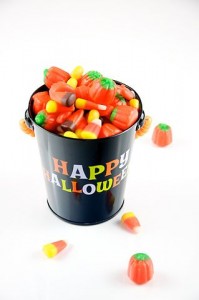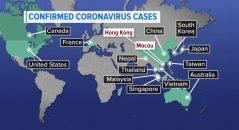 Trick-or-treating is an old fashioned tradition. In fact, the origins of trick-or treating can be traced back to the medieval era! Halloween candy, on the other hand, is a throughly modern product.
Trick-or-treating is an old fashioned tradition. In fact, the origins of trick-or treating can be traced back to the medieval era! Halloween candy, on the other hand, is a throughly modern product.
Most of the ingredient labels for our favorite halloween candies look more like a chemical equation than actual food. The humble candy corn has 14 different ingredients in it!
Every child knows that eating large amounts of candy is bad for your health. However, few people realize that calories, sugar and fat are just the beginning. Many of our favorite halloween candies contain potentially harmful additives.
Scary Halloween Candy Ingredients
Tertiary butylhydroquinone (TBHQ)
TBHQ is a food preservative that is derived from petroleum. It is used to prevent changes in color, smell and flavor in processed foods, cosmetics, perfumes, varnishes and lacquers. In large amounts, 5 grams or more, TBHQ is lethal. Consuming 1 gram of TBHQ could be enough to cause adverse symptoms like nausea. The FDA limits the amount of TBHQ in any food product to just 0.02 percent of the total oils in food.
It would be nearly impossible for you to ingest a dangerous level of TBHQ because it is not stored in the body. For example, you would have to eat eleven pounds of McDonald’s chicken nuggets in order to consume 1 gram of TBHQ. This food preservative will not kill you but it certainly is not healthy!
Hydrogenated palm kernel oil
Hydrogenated palm kernel oil is a processed palm oil palm. Hydrogenation turns liquid oil into a semisolid substance which makes the oil more stable and gives it a better mouthfeel. Unfortunately this process also creates trans fats. Trans fat is particularly bad for your cholesterol levels because it both raises your LDL (“bad”) cholesterol and lowers your HDL (“good”) cholesterol.
In addition to being harmful to your heart health, palm kernel oil has a negative impact on the environment. The production and farming of palm kernel oil has been linked to deforestation.
Food Coloring
The food coloring used to make our M&M’s and skittles bright and cheerful come with some less than cheery health risks. In other countries these dyes are banned or products that contain them are required to post warning labels! The Center for Science in the Public Interest released a study linking these additives to hyperactivity, cancer and allergies. In 1950 food dye Orange #1 was banned from candy because it was linked to illness in children.
Sugars
While this is hardly a revelation, it is worth noting that the primary ingredient in nearly every candy is some kind of sugar. Sugar can be disguised as a number of different ingredients like: Corn sweetener, high-fructose corn syrup, evaporated cane juice, fruit juice concentrates, maltodextrin, and dextrose.
Sugar is not toxic. However sugar is calorically dense and low in nutrients. Many health experts believe that diets high in sugar are a cause of obesity in both adults and children.
Halloween trick-or-treating is a fun time-honored tradition. Unfortunately the subsequent candy binges could expose you and your family to many unhealthy substances.





